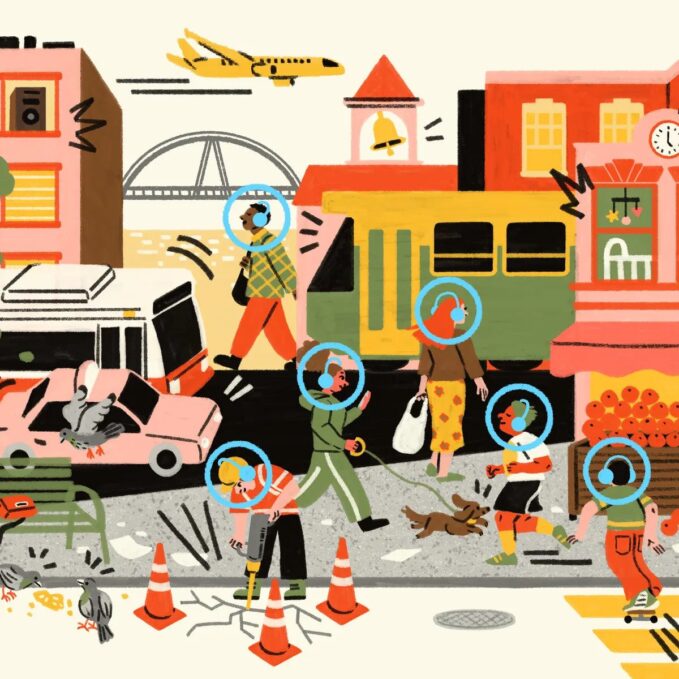
In an increasingly noisy world, people are turning to gadgets and accessories to dial down the volume of their surroundings. From over-ear headphones on public transport and during flights to discreetly nestled earplugs at concerts and crowded bars, the pursuit of silence has become big business. In 2021, the global noise-cancelling headphones market raked in a staggering $13.1 billion, with projections estimating it to skyrocket to $45.4 billion by 2031, as per data from Allied Market Research.
Even Google searches in Australia have reflected this trend, with queries for “noise cancelling” and “earplugs” on a steady rise over the past five years. Earplug brands have gone a step further by marketing their products as tools to combat “parental burnout” for exhausted caregivers. However, the growing popularity of noise-canceling solutions raises a pertinent question: does tuning out the world come with physical and social consequences?
A Historical Perspective:
The inception of noise-cancelling technology dates back to the 1950s when it was primarily developed to reduce cockpit noise for pilots. Bose’s release of the first commercially available headset in 1989, initially designed for aviation, marked the technology’s entry into the consumer market.
Noise-cancelling headphones employ active noise control technology, involving a microphone that captures ambient sounds and an amplifier that generates sound waves exactly out of phase with the incoming noise. This results in the cancellation of noise, primarily effective for sounds below 1kHz, such as airplane engine roars, road traffic drone, or the hum of air conditioning units.
The Hazards of Excessive Noise:
Excessive noise is not just detrimental to hearing; it also poses broader risks to physical health. Long-term exposure to noise pollution has been linked to an elevated risk of cardiovascular diseases, including fatal heart attacks, as well as depressive symptoms. Occupational guidelines stipulate that workers should not be exposed to an average noise level exceeding 85dB over eight hours, equivalent to the sound generated by blenders and leaf blowers.
However, these regulations primarily apply to workplaces with no specific guidelines for recreational noise. Single exposures to noise levels between 100 and 105dB can damage auditory nerves linked to sensory cells in the ear. Such damage often goes unnoticed in clinical audiograms, as these nerves play a crucial role in transmitting information related to hearing in noisy environments.
Moreover, the irony emerges when tech companies, while marketing headphones, simultaneously venture into hearables, personal sound amplification products. For instance, Apple AirPods are marketed with a hearing aid-like functionality, effectively bridging the gap between entertainment and audiological support. By reducing the need to crank up the volume in noisy environments, noise-cancelling technology might offer protection in such scenarios.
The Consequences of Silence:
Excessive reliance on noise reduction can have unintended repercussions. Prolonged use of earplugs, both day and night, over just one week, has been linked to the onset of tinnitus. Remarkably, the tinnitus experienced correlated with the frequency range blocked by the earplugs, primarily perceived as high-pitched.
Ceasing to expose your ears to sound leads to an overcompensation by the brain, increasing its internal gain. This, in turn, leads to a complete alteration of neural pathways. The brain’s evolution has been intrinsically tied to auditory input, making tampering with sound energy entering the ears a potentially risky endeavor.
While there is limited credible research on the benefits and harms of earplugs or white noise machines during bedtime, some studies suggest that using earplugs at night can enhance sleep quality in noisy environments. Nevertheless, there is a growing need for comprehensive research in this area.
Navigating the Soundscape:
Open-plan offices pose unique challenges, with noise-cancelling headphones often becoming a crucial tool for maintaining focus and privacy. The COVID-19 pandemic has reshaped perceptions of noise in the workplace. Remote work illuminated the stark contrast between the noise-free home environment and the often chaotic office atmosphere.
Noise-cancelling headphones have become a sanctuary for concentration, but they are not the ultimate solution. Experts argue for versatile office designs that accommodate various work requirements, such as dedicated spaces for focused tasks and collaborative areas.
In the face of the cacophony of modern life, over-reliance on noise-cancelling technology may not be the answer. Dr. David McAlpine points out that we have outsourced our auditory world in ways we haven’t with our visual world. Imagine replacing all urban beautification efforts with AR/VR goggles, with everyone navigating their private, alternative realities. It’s a concept laden with challenges.
As we continue to navigate a world filled with noise, it’s essential to strike a balance between silencing the external world and embracing the natural soundscape around us. The quest for silence is a journey that warrants careful consideration, acknowledging both its benefits and potential drawbacks.










Leave a Reply